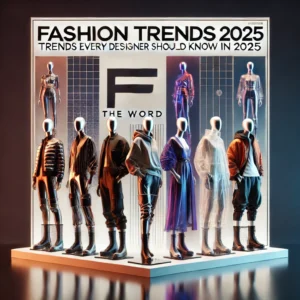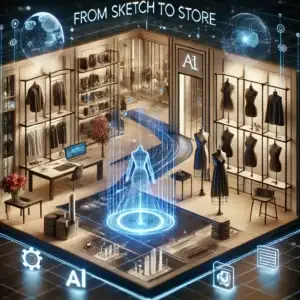Revolutionizing Fashion with Virtual Outfit Creators
Digital fashion is the talk of the moment. It is revolutionizing the way we think about clothing by offering virtual garments designed for digital environments, ecological sketching practices, and exciting fashion marketing opportunities. It’s also expanding possibilities for self-expression in both the real and digital worlds.
What is Digital Fashion?
Digital fashion encompasses clothing that exists purely in digital form, ranging from skins for game avatars to virtual clothes you can wear in augmented reality (AR) environments, and pieces created using 3D fashion design software en route to being physically materialized.
Though it began as attire for avatars interacting in the metaverse, digital fashion has evolved into a full-blown virtual experience. It allows fashionistas to express themselves online or use AR to wear their favorite outfits virtually and post them on social media. Furthermore, brands can use 3D fashion to design and showcase items, then produce them based on demand.
This is why many brands, both mainstream and high-end, have adopted digital fashion—creating virtual worlds for customers to access special experiences and releasing digital versions of their physical collections.
The Benefits of Digital Fashion
Sustainability
Digital fashion is a game-changer for sustainability. Unlike traditional fashion production, which consumes vast amounts of water and materials, virtual fashion drastically reduces brands’ carbon footprints. You can significantly reduce your environmental impact without sacrificing style.
Creative Freedom
Imagine designing clothes without the constraints of fabric or sewing machines. Virtual clothing allows designers to explore limitless possibilities, creating pieces that defy the laws of physics and push the boundaries of creativity. From metallic textures to gravity-defying shapes, the options are endless.
Accessibility
One of the most exciting aspects of digital fashion is its accessibility. Anyone with a smartphone, tablet, or computer can engage with digital clothes—whether as an attendee of a virtual fashion show, a digital fashion designer, or a customer. This inclusivity makes fashion accessible to a global audience, regardless of location or design abilities.
Interactivity
Digital fashion isn’t just about wearing clothes—it’s about experiencing them in new and interactive ways. From mind-blowing virtual fashion shows to virtual clothes try-on sessions, digital fashion engages consumers like never before. It offers immersive experiences that blend the digital and physical worlds seamlessly, introducing the “phygital” way of living fashion.
Cost-Effectiveness
For fashion enthusiasts, virtual clothing offers a cost-effective alternative to traditional shopping. Instead of spending thousands on physical outfits, you can invest in digital pieces that are affordable and reusable across various platforms. Digital fashion designers can save significantly by creating on 3D fashion design software. It’s a savvy way to stay stylish without breaking the bank.
Virtual Outfit Creators: Redefining Fashion Accessibility
Virtual outfit creators are at the forefront of this digital fashion revolution. These innovative tools enable designers and consumers alike to craft, experiment with, and wear digital garments in ways previously unimaginable. From AR try-ons to entirely virtual wardrobes, virtual outfit creators are reshaping how we interact with and experience fashion.
Digital fashion isn’t merely a trend; it embodies the future of fashion in the digital age. With its focus on sustainability, creativity, and accessibility, digital fashion is transforming our relationship with clothing. Whether you’re a gamer, a social media influencer, or simply seeking new avenues for self-expression, digital fashion opens endless possibilities. It invites everyone, regardless of background, to explore innovative ways of dressing, from virtual trends to Instagram-worthy digital outfits.
As this revolution unfolds, digital fashion’s impact on the industry—from enhancing sustainability and creativity to integrating cutting-edge technologies like blockchain and AI—is profound. Embrace the evolution of fashion with digital solutions that redefine how we conceive, create, and engage with apparel, ushering in a future where style meets innovation on unprecedented levels.
FAQs
- What is digital fashion?
Digital fashion refers to clothing that exists purely in digital form. This includes virtual garments designed for avatars in video games or virtual worlds, as well as AR clothing that can be worn in augmented reality environments. Digital fashion is created using 3D fashion design software and can also be materialized into physical garments based on demand. - How does digital fashion work?
Digital fashion works by creating virtual clothes that can be worn in digital environments, such as video games, social media, or AR. Designers use advanced 3D design software to create pieces that can be viewed or worn digitally. These clothes are often showcased in virtual fashion shows or through AR try-ons and can also be converted into physical items based on consumer demand. - What are the benefits of digital fashion?
- Sustainability: Reduces the environmental impact of traditional fashion production, including water usage and material waste.
- Creative Freedom: Designers can create garments without constraints like fabric limitations, allowing for endless creative possibilities.
- Accessibility: Digital fashion is available to anyone with an internet connection, allowing global access to virtual clothing and experiences.
- Interactivity: Offers immersive experiences like virtual fashion shows and try-on sessions, blending the physical and digital worlds.
- Cost-Effectiveness: Virtual clothes are more affordable than physical garments, offering an eco-friendly alternative for consumers and designers alike.
- How does digital fashion contribute to sustainability?
Digital fashion significantly reduces environmental impact by eliminating the need for physical resources such as fabrics, dyes, and large-scale production processes. This helps reduce waste, water usage, and carbon emissions, making it an eco-friendly alternative to traditional fashion. - Can I wear digital clothes in real life?
While digital clothes cannot be worn physically in the traditional sense, they can be showcased in virtual environments, social media, and augmented reality. Some brands offer AR try-on experiences that allow users to “wear” digital outfits virtually, providing new ways of self-expression online.
What else would you like to know about digital fashion?



